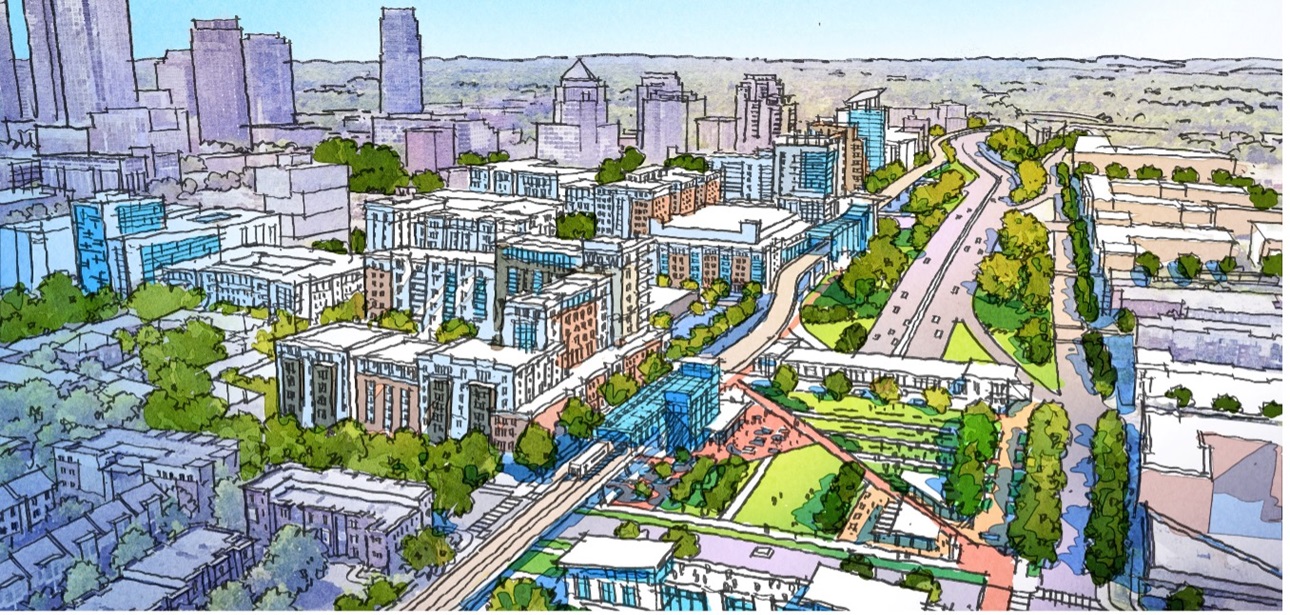Uptown/11th Street Alignment—LYNX Silver Line Charlotte, North Carolina

Advisory Services Panel
The overall study area encompasses about 1.7 square miles within Uptown. The general boundaries are Interstate 277 and CSX Rail to the west. The focused study area (FSA) is located in the northeast section of Uptown Charlotte, bordered by North Poplar and Church streets to the northwest, CSX to the northeast, the Brookshire Freeway to the southeast, and Eighth Street to the southwest. The FSA encompasses about 189 acres, straddling the First and Fourth Ward neighborhoods of Uptown. The general boundaries are about a quarter-mile radius from the two planned LYNX Silver Line station locations along the 11th Street corridor. In the FSA, the Silver Line Locally Preferred Alignment (LPA) has two planned stations: 11th Street/Blue Line Station: along 11th Street at the nexus of the LYNX Blue Line and LYNX Silver Line between College and Brevard streets, and the Davidson Street Station, located on 11th Street between Caldwell and Davidson streets.
Anchored to the northwest and southeast by residential development ranging from single family to high-density multifamily, the center of the FSA consists largely of vacant land, parking lots, and older, underused buildings. The Brookshire Freeway (I-277) bisects the FSA from the northwest to the southeast, creating a substantial barrier between Uptown and the Center City neighborhoods to the north/northeast. Despite robust planning and Charlotte’s recent economic and population growth, this area of Uptown has lagged, not benefiting from the boom in investment seen in other areas of Uptown or adjacent areas outside the I-277 loop. The FSA is currently served by the Charlotte Area Transit System (CATS) LYNX Blue Line at the Ninth Street Station. The Blue Line is the region’s first light-rail service, spanning nearly 19 miles and 26 stations from I-485 at South Boulevard in the south to the University of North Carolina (UNC) Charlotte’s main campus in University City in the north. The future CATS LYNX Silver Line is planned to cross the Blue Line at 11th Street, creating the opportunity for a connection to the existing Blue Line Ninth Street Station.
This would be the only transfer station between the Blue Line and the Silver Line, making it an iconic component of not only the transit system, but also the urban fabric of Uptown Charlotte and the community. The panel explored how the Silver Line could help Charlotte thrive and continue to grow sustainably. Transit is a long-term investment to deliver stronger and more livable communities, although post-pandemic impacts are still emerging. Panelists examined the economic, environmental, and social implications of transit expansion for the region, while focusing on development opportunities for the Center City. Additional panel recommendations weighed in on station design, optimization of project financing, and engaging key partners.
The video for this Advisory Services Panel is available to watch here.
Report Summary: The overall study area encompasses about 1.7 square miles within Uptown. The general boundaries are Interstate 277 and CSX Rail to the west. The focused study area (FSA) is located in the northeast section of Uptown Charlotte, bordered by North Poplar and Church streets to the northwest, CSX to the northeast, the Brookshire Freeway to the southeast, and Eighth Street to the southwest. The FSA encompasses about 189 acres, straddling the First and Fourth Ward neighborhoods of Uptown. The general boundaries are about a quarter-mile radius from the two planned LYNX Silver Line station locations along the 11th Street corridor. In the FSA, the Silver Line Locally Preferred Alignment (LPA) has two planned stations: 11th Street/Blue Line Station: along 11th Street at the nexus of the LYNX Blue Line and LYNX Silver Line between College and Brevard streets, and the Davidson Street Station, located on 11th Street between Caldwell and Davidson streets.
Anchored to the northwest and southeast by residential development ranging from single family to high-density multifamily, the center of the FSA consists largely of vacant land, parking lots, and older, underused buildings. The Brookshire Freeway (I-277) bisects the FSA from the northwest to the southeast, creating a substantial barrier between Uptown and the Center City neighborhoods to the north/northeast. Despite robust planning and Charlotte’s recent economic and population growth, this area of Uptown has lagged, not benefiting from the boom in investment seen in other areas of Uptown or adjacent areas outside the I-277 loop. The FSA is currently served by the Charlotte Area Transit System (CATS) LYNX Blue Line at the Ninth Street Station. The Blue Line is the region’s first light-rail service, spanning nearly 19 miles and 26 stations from I-485 at South Boulevard in the south to the University of North Carolina (UNC) Charlotte’s main campus in University City in the north. The future CATS LYNX Silver Line is planned to cross the Blue Line at 11th Street, creating the opportunity for a connection to the existing Blue Line Ninth Street Station.
This would be the only transfer station between the Blue Line and the Silver Line, making it an iconic component of not only the transit system, but also the urban fabric of Uptown Charlotte and the community. The panel explored how the Silver Line could help Charlotte thrive and continue to grow sustainably. Transit is a long-term investment to deliver stronger and more livable communities, although post-pandemic impacts are still emerging. Panelists examined the economic, environmental, and social implications of transit expansion for the region, while focusing on development opportunities for the Center City. Additional panel recommendations weighed in on station design, optimization of project financing, and engaging key partners.
The video for this Advisory Services Panel is available to watch here.


